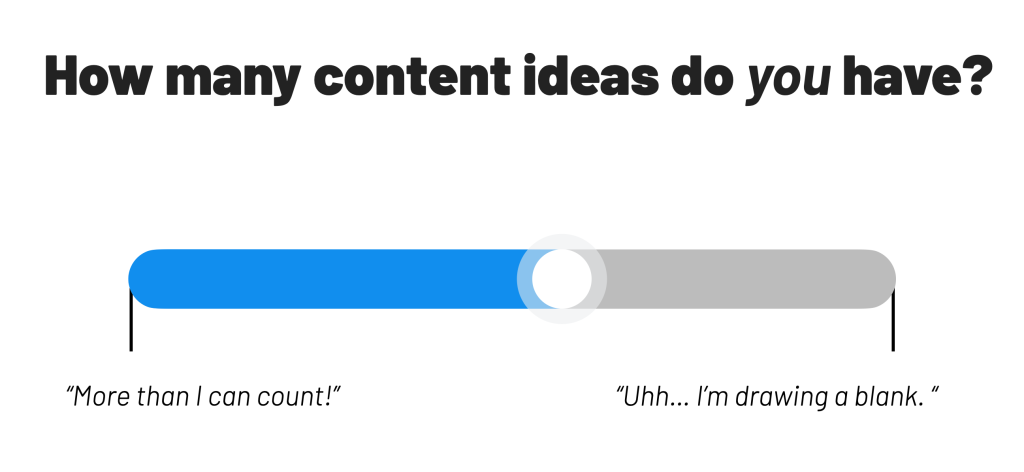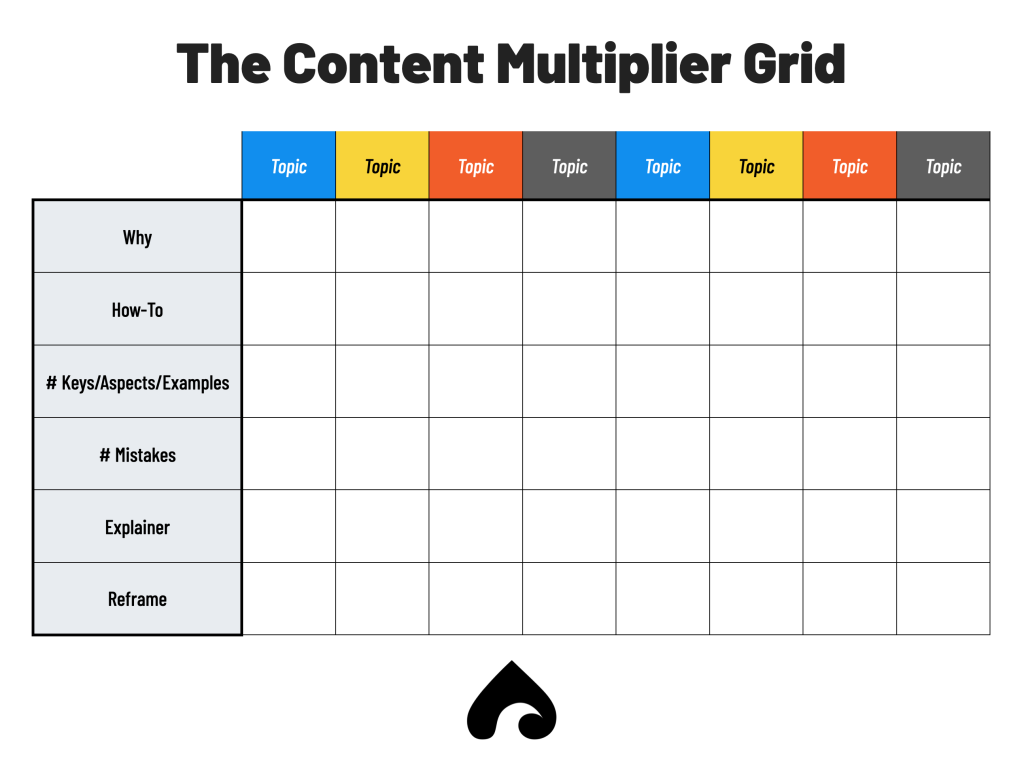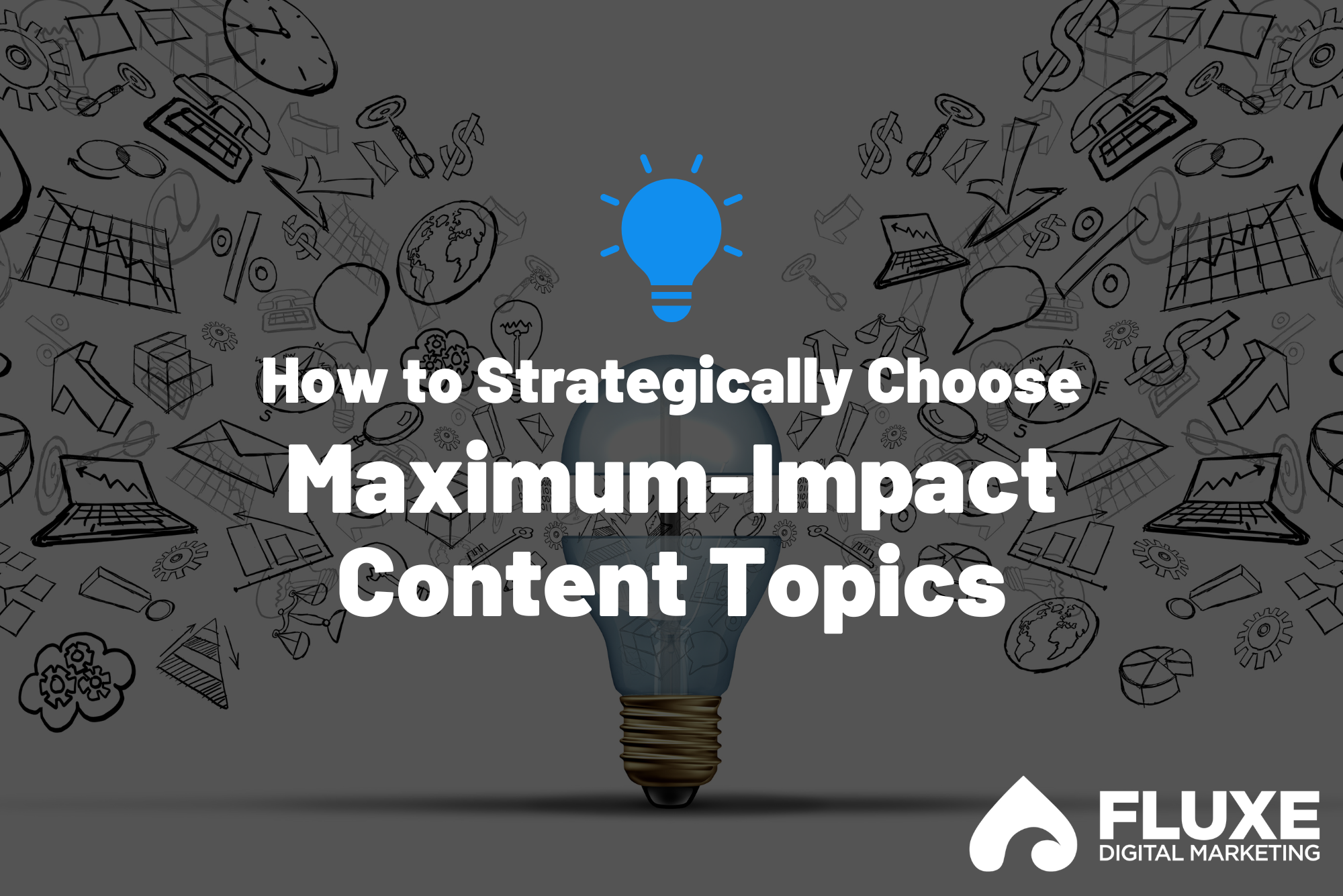When business owners decide to start blogging, their mindset generally falls somewhere on a spectrum between:
- “I have a thousand ideas and need no instruction on how to choose blog topics!”
- “I see the power of content marketing, but I have no idea what I’m going to blog about!”

If you’re struggling with mindset 2, you’re not alone. At some point, every business owner fears they’re going to run out of things to talk about, even if they’ve been creating content for years. It’s a common question our clients pose at the beginning of our relationship: “Aren’t we going to run out of ideas?”
We’re not. We never have, for ourselves or any of our clients (some of whom have published over 300 blog posts).
Whether you’re just getting started or getting out of a rut, here’s how to choose blog topics that make an impact — and ensure you never run out of ideas.
Heads up: You’ll notice that these 5 tactics do NOT include SEO-based keyword research. That’s not an oversight. Keyword research is a great way to generate content ideas (which is why we use it for all our clients), but it requires premium tools and software that most small business owners don’t have access to. The tactics in this post were chosen because they’re highly effective and can be used by anyone, regardless of their tool set.
How to Choose Blog Topics: 5 Idea-Generation Tools
1. (F)AQ
Frequently asked questions, or just asked questions, are the questions your ideal target audience is asking you right now.
These questions can be about anything. For instance, if you’re a concierge doctor, they can be about your philosophy of care, your practice, how a new patient can get started, or clinical issues like how to get better quality sleep, lower blood pressure, or boost your immune system.
Each of these questions offers the basis for the topic of a blog post.
Owners sometimes ignore questions about their philosophy because they don’t believe their target audience will find value in it. This couldn’t be further from the truth. Information about your philosophy or onboarding process can motivate someone in the consideration stage of your sales funnel to choose you over your competitor. Remember, content can serve many purposes beyond initial awareness.
Plus, if people are asking you questions in person, there’s a decent chance they’re asking Google the same thing. FAQ-based content can have a great SEO impact.
Wondering how to choose blog topics from these questions? Start with the ones you’re most frequently asked. Once you’ve covered these, tackle the less common ones. A question only one person asks is still worth writing about because one bold person may represent 50 reserved prospects who aren’t sure how to word their conundrum.
This is why you need to document everything.
We recommend using an FAQ tracker, which is a simple spreadsheet. Our go-to platform is Google Sheets (sorry, Excel fans), as you can easily share it with your whole team. Have your team fill out the FAQ tracker with the following information every time they’re asked a question:
- The question that was asked.
- The person who asked it. (This can be a role instead of a name. Following our medical example, was it a team member? A patient? A new prospect?)
- The person who was asked. (Physician? Front desk staff? A medical assistant? An RN? This gives you a better idea of the point of awareness at which the question is being asked.)
Click here to download the FAQ Template.
2. SAQ
Ever heard the adage, “There’s no such thing as a stupid question”? It’s incorrect. There are stupid questions, but people ask them all the time.
Instead of answering those stupid questions, tell your audience what better questions they should ask instead. Should ask questions (SAQ) are the concepts you end up explaining after someone asks “the wrong” question.
Low-priority questions will still be addressed in your content, but there’s more you can contribute beyond direct answers to direct questions. SAQ content is more valuable to your audience because you’re leading them through a mindset shift. They need a new lens to see a topic through, and by providing that lens, you demonstrate your value and authority.
Let’s stick with the concierge physician example. A patient asks, “What are the best medications to take for high blood pressure?” The better question is, “Why do I have high blood pressure in the first place, and how can correcting the root cause prevent the need for blood pressure medication altogether?”
Or, let’s say you’re an entrepreneur and a prospective buyer asks, “What’s the price of your product?” What you’d like them to ask, in addition, is, “What’s the cost to me if I don’t buy your product?”
You’re an expert, and helping people reframe their questions is a great way to demonstrate that. What questions do you wish people were asking? Start addressing those. You can create a separate SAQ tracker similar to your FAQ tracker, or you can merge your SAQ and FAQ trackers into one AQ tracker.
3. Competitor Content
If your clients aren’t getting the answer to their questions from you, they’re getting it from somebody else.
If you’re a physician and your patients have a serious issue with their health (or your practice), they’ll ask you about it directly. However, there’s a ton of information your patients are interested in that they may not bring up during appointments (tactics for weight loss, news about the latest medications, the validity of something they read on USA Today, etc.).
That’s why you need to join the digital discord.
Look to your competitors to see what they’re addressing in their content. If they’re writing about it, your clients and prospects could be reading it. Look at their sites, join their email lists, monitor their social media, and watch their videos.
Important note: We aren’t telling you to rip off your competitors’ content. We also aren’t saying you should “one up” your competitors’ content by copying their blog posts and adding 50 more words. Providing superior value is about more than just word count. You have something fresh to say regarding the topics your competitors are writing about. Infuse each piece of content with your unique experience and expertise.
4. Tangential Content
Consider the other companies that serve your clients alongside you. They may offer a completely different product or service, but they still provide value to your target audience. Tangential content is content you can create about those overlapping interests.
For example, if your company manufactures hunting knives, a tangential company may manufacture tents for backcountry adventures. They don’t make knives, and you don’t make tents, but because you share an audience, you can observe their approach to content and let it inform your own.
For example, your next blog post may be titled, The Best Camping Gear for Your Next Backcountry Hunt. That’s you providing value to your audience and positioning yourself as a trusted advocate for their needs.
This can be tricky because you shouldn’t BS your readers by discussing topics you don’t know anything about. Instead, as you’re learning how to choose blog topics, do your research and explore where your existing audience is shopping.
5. Influencer Content
There are people your audience goes to for thought leadership, entertainment, and education. These people are talking about the same topics as you, but they aren’t selling the same thing.
Are you an entrepreneur? Influencers like Tim Ferris speak directly to your audience, even though he isn’t selling the product or service you are. That audience overlap is still worth exploring. Look to his content to see what resonates with your shared audience, and mine those ideas.
Mix and Multiply
Once you have a robust list of blog topics, you might discover some aren’t that well defined. How do you flesh out blog topics and ensure you never run out of them? Use our Content Multiplier Grid.

This is all about remixing blog topics. The column on the left-hand side is filled in with different approaches, or content frameworks. Just place your loosely defined topics across the top row, and work your way down.
Let’s use the topic “lifestyle changes for weight loss” as an example. Here are some alternative approaches to that topic:
- Why: What’s the importance of doing something, or why shouldn’t you do something? E.g., “Why approaching weight loss with lifestyle modification is more sustainable than fad supplements” and “Why you need to pursue weight loss naturally through lifestyle changes.”
- How-To Steps: Tactical, step-by-step strategies. E.g., “How to lose weight naturally” and “How to lose weight through lifestyle changes alone.”
- # Keys/Aspects/Examples: Insider tips and overlooked secrets. E.g., “What your doctor wishes you knew about weight loss” and “Unlocking the secrets of natural weight loss.”
- # Mistakes: Discuss common mistakes and offer remedies. E.g., “10 mistakes people make when trying to lose weight naturally.”
- Explainer: Introduce a new concept without nitty-gritty how-tos. This works well when you want to introduce new concepts that are a little heady or philosophical. E.g., “How small lifestyle changes make the biggest impacts with weight loss.”
- Reframe: Shift the reader’s mindset about a certain topic. This approach turns an FAQ into an SAQ. E.g., “Why pharmaceuticals aren’t a sustainable weight loss method.”
How to Choose Blog Topics: Final Thoughts
If you want to learn how to choose blog topics that will position you as an industry leader, start with the types of content discussed above.
Not every blog topic you come up with can make the highest impact (that’s a conversation for another day), but with this strategy, your content well will never fail to overflow with valuable ideas.



